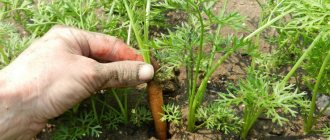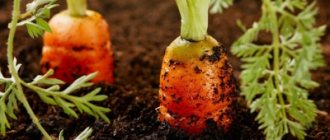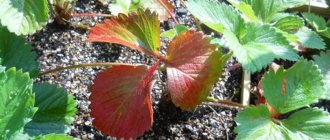Reasons why carrots turn black after peeling
Darkening of a vegetable after peeling occurs for various reasons . Of these, only one can be called harmless - oxidation. In other cases, it is not recommended to store or eat blackened carrots.
The minerals that make up carrots oxidize when exposed to oxygen and turn black. Beta-carotene is the pigment responsible for the orange color of the vegetable. It quickly oxidizes when exposed to air and loses its original orange color.
Excess fertilizer
Another reason carrots turn dark after peeling is that too much fertilizer was used when growing them. Such a vegetable cannot be called healthy.
Take note:
Improper cleaning
Peeling with a dull knife and removing too thick a layer of skin leads to blackening of the root vegetable.
Storage errors
Not all carrot varieties are suitable for long-term storage . Varieties such as Chance, Moskovskaya, Samson, Dolyanka, Touchon, Dordogne, Champion are more resistant to diseases and pests and are preserved throughout the season. However, there are varieties that deteriorate when stored for a long time and darken when cleaned.
Important! Under incorrect storage conditions (temperature above 28°C, humidity 90-100%), carrots develop black rot. The symptoms of this disease are as follows: dry, dark and depressed spots are visible on infected specimens. Dead tissue turns black over time. And the stain itself penetrates 1-1.5 cm deep into the pulp and has clear boundaries. A dark olive-colored coating of fungal mycelium remains on the spots.
Types of carrot rot
Soft rot (mucous bacteriosis).
You can often notice the first signs of the disease in the garden: the leaves darken and wither, parts of the tops may be covered with mucus. However, most often the disease manifests itself after storing the crop. The insides of the root crop soften, turning into a characteristic putrefactive mass with an unpleasant odor, while the skin may remain intact. Sometimes the first sign of soft rot is dark spots with an unpleasant odor that quickly increase in size. Soft rot tends to quickly move from diseased root crops to healthy ones and can destroy the entire crop in storage. Damaged carrots should be removed from storage immediately.
soft rot of carrots
Alternaria (black rot).
A fungal disease develops especially actively in high humidity. In damp and cold summers it can cause the death of the tops: the leaves turn brown and black, starting from the tips, and quickly rot. During storage, Alternaria manifests itself by the appearance of dry, dark, depressed spots, on which a greenish coating of mold may be detected. Gradually, dense rot of an intense black color develops in their place. Like other fungal infections, Alternaria quickly spreads in storage. The infection is also dangerous because it is easily transmitted through infected seeds and leads to seedlings becoming infected with blackleg.
black rot of carrots
Fomoz (dry, brown rot).
A characteristic sign of phomosis is the appearance of spots or transverse stripes, first at the top of the root crop and gradually spreading over the entire surface. The spots are dark, depressed, with a brownish tint; fungal spores may be visible in the form of dark dots. Over time, deep ulcers and white rot appear in their place.
phomosis of carrots
Scab (rhizoctoniosis)
A disease of fungal origin, it manifests itself on root crops with gray spots, which then acquire a purple tint. As the disease progresses, the carrots dry out and may be additionally affected by various types of rot.
carrot scab
Sclerotinia (white rot)
A common fungal disease that affects a wide variety of crops, even trees and shrubs. On carrot root crops it manifests itself as softening and watery tissue in the absence of a putrefactive odor. A dense white coating, reminiscent of cotton wool, quickly forms on the affected areas. Sometimes there may be no plaque; the disease is determined only by the progressive softening of the roots. The spread of the disease in the storage facility is facilitated by high temperature (above +20 °C) and humidity of more than 90%.
white rot of carrots
Why do grated carrots turn dark?
Instant blackening of grated carrots is rare . If the fruit was initially whole, without cracks or brown spots, it will oxidize when rubbed. The product may darken if the root crops showed signs of past diseases or pests. The consumption of such carrots is strictly contraindicated.
Causes of darkening during cooking
When cooked, a vegetable darkens if it was cooked in the same pan along with other vegetables : potatoes, beets, etc. The structure of the vegetable absorbs the coloring enzymes of other vegetables and darkens. There is nothing wrong with this - such a vegetable is suitable for cooking.
After washing
Dark spots on washed carrots indicate diseases that were not visible externally due to contamination. Such diseases include black, white, gray rot, brown spot or phomosis. Diseased root vegetables cannot be stored or processed.
Carrot pests
Carrots have few pests, but their attacks can lead to complete loss of the crop. Let's learn about the most harmful insects that feed on the aboveground and underground parts of carrots.
psyllid
The psyllid, like ordinary fleas, has jumping limbs. Thanks to their jumping ability, insects can move long distances. This is a very small pest, but it can cause significant damage. The source of insects is pine plantings.
The pest is extremely difficult to destroy, so it is recommended to take preventive measures - cover the plantings with non-woven material in advance.
Harm and signs of damage. Females lay eggs on carrot tops. The larvae emerging from the eggs feed on the sap of the leaves. The plant may dry out completely, and the roots stop growing.
Control measures:
- Treatment with soap solution or tobacco dust. For 10 liters of water take 1 kg of tobacco and 30 g of laundry soap.
- Scattering or laying out coniferous branches between rows.
Umbrella moth
The carrot or umbrella moth is a small butterfly. There are several varieties of moths, the brown one is especially dangerous, affecting fruits and testes. The moth activation period is late June to mid-July. It affects parsnips, fennel, cumin, dill and other umbelliferous plants.
The first caterpillars appear at the end of June. The caterpillars develop in about 20 days. Having pupated, they do not threaten the harvest - until next year. To prevent the development of pests, deep autumn digging of the soil is recommended.
Harm and signs of damage. Pests weave cocoons - from these you can guess the presence of a pest. Plants darken and dry out.
Control measures:
- Tops cutting and mechanical collection of tracks.
- Spraying with preparations of lepidocide, entobacterin, etc. during the budding period.
Naked slugs
This voracious pest is especially active in damp, rainy weather. Both adult slugs and larvae are dangerous to the crop. Pests usually hide under stones or among tops.
The pest constantly reproduces and lays eggs throughout the summer and autumn, so it can cause enormous damage to the crop. The female is capable of laying half a thousand eggs at a time. Hatched slugs become full-fledged pests of garden beds within 2-3 weeks.
You should not grow carrots in lowlands where moisture stagnates - there is a high risk of slug damage.
In addition to carrots, slugs also eat other garden crops. It is extremely difficult to lime them - it is difficult to determine the places of their “dislocation”. They usually spread throughout the area. It is recommended to look for slugs under stones, boards, and other objects that have been standing for a long time without changing place.
Harm and signs of damage. Slugs eat tops and root crops. The presence of slugs can be diagnosed by the light paths that follow their trail. Slugs usually crawl out at night or immediately after rain.
Control measures:
- Treating the ground with lime mortar to which wood ash is added.
- Regular weed removal is the best way to combat slugs.
Wireworms
Wireworms are hard yellow worms reaching a length of 3 cm. These are the larvae of the click beetle. The insect is especially dangerous in the first half of summer. By the beginning of August, the larvae, having pupated, become harmless to carrots.
Wireworms are especially common in potato beds. This is the most dangerous potato pest. Optimal conditions for the pest are soil humidity of about 50%, air temperature above +20°C. In low humidity, worms die quickly, but in dry environments, plants also die.
Harm and signs of damage. Worms feed on root crops, eating out thin passages in them. By gnawing through the pulp, the wireworm makes the root crop vulnerable to various infections. Chewed carrots are not suitable for food or storage.
Control measures:
- Liming the soil.
- Application of ammonia-containing preparations - ammonium nitrate, ammonium chloride, etc.
carrot fly
This is the most common and harmful insect for carrots. Eggs are laid directly on the plant or on the soil near it. The first attacks begin at the end of May.
The fly is dangerous at all stages of carrot development. It is important to take measures to destroy the laid eggs. But to cope with the fly, you need a whole range of agrotechnical measures.
Harm and signs of damage. Having hatched from the eggs, the larvae gnaw holes in the root crop. You can guess about fly infestation by the tops - they acquire a yellow or purple tint, and the root vegetables become bitter. The tops wither and the root crops become inedible.
Control measures:
- Spraying with chemicals - Ziper, Shar Pei, etc.
- The use of folk remedies is treatment with a solution of ash, slaked lime and tobacco dust, taken in equal parts. The mixed components are scattered between the rows.
exclamation scoop
This is a butterfly whose caterpillars infect all parts of the plant. This is a polyphagous pest. Harmful to grain, industrial and vegetable crops. Butterflies appear in early May and feed on flowers for some time.
Harm and signs of damage. Caterpillars eat stems and fruits, eating holes in them
Control measures:
- Spraying with insecticides - Decis, Polytrin, Fury.
- The use of traditional methods - spraying with infusion of burdock and chamomile.
Root nematode
These are small white worms that live in the ground. Their length is 0.5-1.5 mm. Harm the root system. Worms are found in the top layer of soil. Gnawed passages destroy root crops.
Nematodes can stay in the soil for years and then infect the entire crop. Active reproduction begins in hot and humid weather. There is no clear way to kill nematodes.
Harm and signs of damage. Root crops, due to worms penetrating inside the root crops, are covered with growths and swellings - galls in which these insects reproduce - nematodes lay eggs in them.
Control measures:
- Replacement of affected soil.
- Burning affected plants.
- Soil treatment with formaldehyde.
Medvedka
This insect is dangerous for most garden crops. The mole cricket lives underground and reaches 5-6 cm in length. It has powerful jaws and a strong shell. The danger is posed not only by the adult insect, but also by the larva.
In a short time, the insect can destroy a significant part of the crop. To prevent the spread of mole crickets, careful and deep digging of the soil is recommended.
Harm and signs of damage. The mole cricket chews through roots and young shoots. The plant dies.
Control measures:
- Treatment with kerosene or washing powder.
- Tincture of mustard, alcohol and pepper, mixed in a ratio of 1:1:10.
- All kinds of traps - dung, beer, etc.
- Chemical preparations - for example, granular preparations “Grizzly”, “Medvetox”, “Grom”.
What to do
Carrots that turn black after peeling or washing are thrown away . Darkening of the fruit indicates a loss of taste and beneficial qualities, the presence of excess nitrates in the product and tissues that have suffered from the disease. Darkened vegetables are not processed. Removing the darkened parts is also of no benefit, since the painful blackening damages the entire fruit.
Is it possible to eat these carrots?
If the reason for the blackening of the vegetable was improper storage, then the product is no longer suitable for food and must be disposed of. It does not preserve valuable substances - at best, it will simply be useless.
Carrots stored for too long pose a health risk : poisoning occurs when consumed.
Vegetables grown with a lot of chemicals and other fertilizers are definitely not suitable for food.
Carrots that have darkened due to oxidation are used for cooking or freezing.
Preventive measures
To prevent carrots from turning black, it is recommended to follow preventive measures:
- buy only high-quality vegetables from trusted manufacturers or distributors;
- choose vegetables of medium weight - about 150 g: such a fruit has the optimal presence of valuable minerals and vitamins, and the content of harmful substances is minimal;
- root vegetables that are too large accumulate nitrates and do not benefit the human body;
- When peeling carrots, remove a thin layer of skin with a sharp knife or vegetable peeler;
- cook separately from other root vegetables and do not overcook;
- to preserve vitamins, immerse carrots in boiling water;
- It is recommended to cook and stew the vegetable under a closed lid;
- for storage, choose vegetables that are not damaged and store them in the right conditions;
- do not store peeled carrots for a long time - to prevent the product from spoiling, grate it, place it in a plastic container or vacuum bag and freeze it;
- Remove the tops immediately after harvesting.
Prevention of carrot diseases
- Selection of healthy root crops for seeds. To avoid receiving initially contaminated seeds.
- The right fertilizer. Too much nitrogen, as well as neglect of microelements, increases the incidence of disease.
- Proper watering. Abundant watering in the heat leads to cracking of root crops, which are subsequently affected by diseases. It is advisable to warm up the water in advance (just let it sit). The addition of mullein solution, microelements, and bioactive components improves plant nutrition and increases resistance to disease.
- Processing storage facilities before storing root crops. Whitewashing, treatment with sulfur bombs or formaldehyde, and other septic tanks destroy pathogens in the storage and prevent infection.
- Sowing. Excessively thickened plants “drain”, forming small root crops. At the same time, resistance to diseases decreases.
- Pest control. They carry some of the diseases. In addition, damaged vegetables become sick more easily.
- Agricultural technology. Any deviation from optimal growing conditions leads to weakening of plants and, as a result, increased susceptibility to disease.
- Choosing a location. Growing in unsuitable soil - too wet, heavy, acidic - weakens the plant. It is preferable to reduce the acidity to the required pH 6.5-7 by introducing calcium-containing additives under the predecessor.
- Limiting injuries. Damage to root crops is a gateway to infection.
- Avoiding nitrogen application before harvesting. Reduces shelf life. With the simultaneous application of phosphorus-potassium fertilizers, it is not so critical.
- Stick to crop rotation. Eliminates the accumulation of specific pathogens of carrots in the soil.
- Removal of crop residues. Same goal.
- Growing resistant varieties. Saves time and resources, since such varieties suffer less disease under the same growing conditions.
Storage tips
To avoid rotting, unpeeled carrots should be stored in a cool place at a temperature of 1 to 3°C and a humidity of no more than 80%. A cellar or refrigerator is suitable for this purpose. It is placed in the cellar in open boxes made of plastic, wood or in plastic bags with holes. Any containers in which carrots are stored for a long time must be ventilated.
In the refrigerator, the root vegetable is wrapped in cling film or parchment paper and placed in the department for storing fruits and vegetables. In cool conditions, carrots are edible for 2 months, after washing whole fruits - 1-2 weeks.
Healthy and whole vegetables are selected for long-term storage . If there are a lot of them, before storing them in storage, the root crops are sprinkled with chalk dust or placed in a container with sand and chalk (in a 1:1 ratio). In this state, carrots do not spoil all winter.
Important! In the fruit and vegetable department, carrots are stored separately from apples, cabbage and tomatoes. Shared storage speeds up the process of product spoilage.
Grated or chopped vegetables can be stored in the refrigerator for 2 days . Frozen - one year. The culture cannot be defrosted and frozen again: it loses most of its beneficial qualities.
White rot (sclerotinia)
One of the most common diseases affecting carrots during storage. It is caused by a fungus that is not active in the summer, but “wakes up” by the time the root crops ripen, and at a temperature of 15-20°C it begins to grow. White rot can be detected during the harvest period. Sources of infection can be soil, storage facilities and premises in which vegetables and infected plant residues are stored. The peak of disease activity occurs 4-9 weeks after carrots are placed in storage.
First of all, the fungus affects unripe, overripe, withered or supercooled root crops during harvesting. The infection attacks all vegetables located in the “affected zone”; fruits are not suitable for food. Sick carrots cannot simply be thrown away, especially in the compost heap. Fungal spores can remain on walls, other plants and tools and will attack the crop again next season.
Symptoms : the tissue of the root crop in the affected areas becomes soft, loose and moist (slimed), while the color of the carrots does not change. Subsequently, the “wounds” are covered with a layer of filamentous mycelium of pathogenic fungi, similar to white cotton wool. Over time, it thickens, droplets of liquid appear on it, and then hard and large black growths form.
Measures to combat white rot:
1. Observe crop rotation - plant carrots in the same place only after 3-5 years, and its predecessors should not be cucumbers, tomatoes, parsley, lettuce and cabbage. 2. Harvest the harvest from the garden in a timely manner, sort it carefully and store it at the optimal temperature (0-2°C, with a humidity of 85-90%). 3. Treat the storage room with a solution of bleach: dilute 400 g of lime in 10 liters of water and spray the walls and floor of the room, using 2-3 kg of the substance for every 10 cubic meters. After disinfection, ventilate the room. 4. Whitewash wooden shelving (if any) with lime milk. To do this, dilute 1 kg of lime in 10 liters of water and apply the solution to the racks in an even layer. 5. In the spring, before sowing, add 4-5 kg of humus, 20 g of superphosphate and 10-15 g of potassium chloride to the soil. Do not forget to apply phosphorus and potassium fertilizers in the future. 6. Choose carrot varieties that are resistant to white rot. Burn affected fruits.
The following carrot varieties are considered relatively resistant to white rot: Aristo, Artek, Callisto, Magno, Forto.
Why do peeled carrots turn black?
Darkening of a vegetable can occur for several reasons:
- Oxidation of the mineral substances that make up root crops occurs under the influence of oxygen.
- Peeling with a dull knife and removing too thick a layer of skin.
- Using large amounts of fertilizers during cultivation.
- Selecting a variety that is unsuitable for long-term storage.
- Incorrect storage conditions.
During cooking, the root vegetable may darken if it was cooked in the same container with other vegetables, for example, potatoes, beets. The loss of taste of the peeled fruit occurs due to loss of moisture, withering and drying out.
Protection measures
To improve the resistance of carrots to diseases and increase shelf life, the following measures must be observed:
1 Select a disease-resistant variety (hybrid). Research conducted at VNIIO in 2005-2008 showed that the hybrids F1 Olympetets, NIIOH 336, F1 Callisto, F1 Zvezda, varieties Berlikum, Rote Risen (Yanchenko and others) are the most resistant to major diseases during long-term storage.
2. Plant on soils with a light mechanical composition, ensure sufficient aeration and water permeability.
3. Rotate crops correctly. Good predecessors of carrots are cabbage and potatoes.
4. Application of phosphorus and especially potassium fertilizers. At the same time, excess nitrogen fertilizers reduces the stability of the crop.
5. Follow cleaning deadlines. Storing physiologically mature root crops for storage. In the Non-Chernozem Zone of the Russian Federation, carrots intended for long-term storage should be harvested from the 3rd ten-day period of September to the 1st ten-day period of October. There are fewer losses when storing standard, well-ripened, healthy root crops without symptoms of disease infection.
6. Techniques such as sanding and claying are used to protect products from moisture evaporation, wilting and disease. Dusting with chalk (200-250 g/10 kg) suppresses the growth of phytopathogenic fungi.
7. The development of diseases is inhibited by the increased (3-4%) content of carbon dioxide in the environment.
8. The cellar must be cleaned and disinfected before storing. It is important not to disturb the temperature (0...+1°C) and air humidity (90-95%) in the cellar.
Prevention measures
- To prevent carrots from darkening, the following preventive measures must be taken:
- Purchase only high-quality fruits from trusted sellers.
- When buying root vegetables, choose ones that are not too large - they accumulate a large amount of nitrates. The optimal weight of a vegetable is 150 g. It is this fruit that contains a sufficient amount of vitamins and minerals and a small amount of harmful substances.
- Peel with a sharp knife and remove a thin layer of skin.
- Cook separately from other vegetables.
- Do not overcook.
- Whenever possible, use fresh rather than cooked vegetables in your dishes.
- To preserve vitamins, the root vegetable should be immersed in boiling water and cooked or simmered with the lid closed.
- Store vegetables according to recommendations.
- If the fruits have been peeled but not used immediately, they can be grated, placed in a vacuum bag or plastic container and frozen.
Recommendations for proper storage of carrots
Unpeeled carrots should be stored in the cellar or refrigerator. In the cellar it is placed in boxes made of wood or plastic or plastic bags. In the refrigerator, the vegetable is stored in a tray specially designed for vegetables. It should be wrapped in cling film and paper.
Shelf life in cold conditions is 2 months, after washing - 1-2 weeks. Storage at home is also possible. The time within which such a product should be consumed is 1 month. You can extend the life of fruits by claying them or sprinkling them with sawdust.
Peeled root vegetables, which are planned to be used within 2-3 hours, can be stored at room conditions, in a container without water, covered with a damp cloth. This way it will be possible to preserve the maximum amount of valuable elements and moisture in them.
In the refrigerator, carrots must be stored separately from vegetables and fruits such as apples, cabbage, and tomatoes. Shared storage contributes to their rapid deterioration.
Chopped or grated vegetables can be stored in the refrigerator for up to two days. It should be wrapped in a damp cloth and placed in a plastic bag. After blanching and freezing, the fruits are suitable for consumption throughout the year.
So, after peeling or cooking, carrots may lose their beautiful and appetizing color. To prevent this from happening, you should follow the rules for choosing it when purchasing, cleaning and cooking.
Prevention of pest attacks
- Early sowing of carrots and other umbellifers, so that the plants have time to get stronger before the massive flight of flies.
- Placing crops in open, well-ventilated, sun-warmed areas with light soils.
- Removal of wild umbellifers, dandelions, and clovers. These plants are suitable for feeding adult flies and can become a reservoir for larvae, which will then move on to plant carrots.
- Periodic loosening of row spacing (but without exposing root crops and mandatory abundant watering before loosening). In this case, moisture in the soil is better retained, gas exchange and conditions for the growth and development of plants in general will improve, weeds develop worse, and more eggs laid by the fly and hatched larvae die in the dried out top layer of soil.
- Thorough weeding no later than in the phase of two true leaves, and timely thinning with the removal of damaged plants. Do not leave weeded plants between rows, as their smell will attract carrot flies. Place all removed weeds and substandard carrots in compost or destroy them.
- You can mulch carrot crops with peat crumbs since the carrot fly avoids peat soils.
- Compliance with crop rotation: carrots should not be sown after carrots or in those beds where other umbrella crops were grown last season (that is, where the carrot fly may have overwintered).
- Using natural repellents: water the beds twice with an infusion of onion peels: the first time after thinning and weeding, the second time after weeding in late July - early August. A third of a bucket of onion peels is poured with boiling water (until the bucket is full). When the infusion has cooled, the beds are watered with it, and the onion peels used for the infusion are laid out between the rows.
- You can spray the soil and plants with infusions of black or red pepper (1 tablespoon per 10 liters of water), garlic, marigolds, and tomato tops. But in order for the smell to remain constantly over the carrot bed, it must be sprayed every three days.
- To repel carrot flies, use a mixture of tobacco dust and dry sand in a 1:1 ratio, wood ash, mustard, hot ground pepper (1 teaspoon per 1 liter jar of dry sand) or dry peat. They sprinkle the soil along the rows 2–3 times per season.
- You can plant onions and garlic around the perimeter of the area with carrots, or alternate beds with these plants. You can add tagetes (marigolds) or calendula to your carrot plantings, as these plants attract ichneumonids, the natural enemies of the carrot fly.
Why do peeled carrots turn black?
Darkening of a vegetable can occur for several reasons:
- Oxidation of the mineral substances that make up root crops occurs under the influence of oxygen.
- Peeling with a dull knife and removing too thick a layer of skin.
- Using large amounts of fertilizers during cultivation.
- Selecting a variety that is unsuitable for long-term storage.
- Incorrect storage conditions.
During cooking, the root vegetable may darken if it was cooked in the same container with other vegetables, for example, potatoes, beets. The loss of taste of the peeled fruit occurs due to loss of moisture, withering and drying out.
Alternaria (black rot)
Alternaria blight or black rot appears in the first week after carrots are placed in storage. However, it often happens that its appearance goes unnoticed.
The root vegetable itself remains hard, and with high humidity in the cellar, gray-green mold forms on it. If the humidity is within normal limits, the mold spots themselves will be dry to the touch, dark and slightly depressed. If you cut a carrot in the area where the spots form, you will notice infected coal-black tissue on the cut.
The disease penetrates into the internal parts of the root crop through wounds and scratches accidentally caused during digging and moving. Sources of infection are usually seeds, carrot tops and soil, with which the infection enters the storage room.
The spread of Alternaria occurs through the air or through contact of root crops with each other during storage.
Prevention measures
- To prevent carrots from darkening, the following preventive measures must be taken:
- Purchase only high-quality fruits from trusted sellers.
- When buying root vegetables, choose ones that are not too large - they accumulate a large amount of nitrates. The optimal weight of a vegetable is 150 g. It is this fruit that contains a sufficient amount of vitamins and minerals and a small amount of harmful substances.
- Peel with a sharp knife and remove a thin layer of skin.
- Cook separately from other vegetables.
- Do not overcook.
- Whenever possible, use fresh rather than cooked vegetables in your dishes.
- To preserve vitamins, the root vegetable should be immersed in boiling water and cooked or simmered with the lid closed.
- Store vegetables according to recommendations.
- If the fruits have been peeled but not used immediately, they can be grated, placed in a vacuum bag or plastic container and frozen.
Treatment of carrot diseases.
Seed dressing. TMTD or other fungicides are used. Short-term, 10-minute heating in water at a temperature of 52˚C also destroys pathogens.
Sprouted seeds cannot be heated!
Treatment of crops with fungicides. At the moment, a bunch of drugs have been invented. And they come up with more. This is due both to the discovery of new active ingredients and to the marketing moves of manufacturers. It is inappropriate and impossible to provide all the norms and doses in this article. It is worth using the instructions for the medications and your common sense. It is clear that it should be processed only after the diagnosis has been established, that is, the type of disease. Do not confuse an infectious disease with damage from frost, heat, overdoses or lack of fertilizers.
Carrots are mainly affected by fungal diseases. The fact is that the skin of root vegetables is thin, so they are stored at high humidity to avoid drying out. But it is high humidity that favors the development of fungal diseases of carrots...
It is advisable to pay more attention to prevention rather than to abundant spraying of plants after the development of the disease. Easier and more efficient. And you don’t have to worry about toxic residues in the products.
A lower temperature helps in storage, slows down the development of diseases and loss of goods during storage. It makes sense to reduce the temperature in the storage as much as possible, but not below 0 °C!
Recommendations for proper storage of carrots
Unpeeled carrots should be stored in the cellar or refrigerator. In the cellar it is placed in boxes made of wood or plastic or plastic bags. In the refrigerator, the vegetable is stored in a tray specially designed for vegetables. It should be wrapped in cling film and paper.
Shelf life in cold conditions is 2 months, after washing - 1-2 weeks. Storage at home is also possible. The time within which such a product should be consumed is 1 month. You can extend the life of fruits by claying them or sprinkling them with sawdust.
Peeled root vegetables, which are planned to be used within 2-3 hours, can be stored at room conditions, in a container without water, covered with a damp cloth. This way it will be possible to preserve the maximum amount of valuable elements and moisture in them.
In the refrigerator, carrots must be stored separately from vegetables and fruits such as apples, cabbage, and tomatoes. Shared storage contributes to their rapid deterioration.
Chopped or grated vegetables can be stored in the refrigerator for up to two days. It should be wrapped in a damp cloth and placed in a plastic bag. After blanching and freezing, the fruits are suitable for consumption throughout the year.
So, after peeling or cooking, carrots may lose their beautiful and appetizing color.
To prevent this from happening, you should follow the rules for choosing it when purchasing, cleaning and cooking. Question and answer
In the spring, when I peel carrots, I often find black spots in the pulp. Why do they appear, because the harvest was stored in good storage, the roots were healthy? Valentina Suvorova.
Carrots during storage suffer from various rots - black, white, gray and dry. With black Alternaria, dark, slightly depressed spots appear on root crops. If the air humidity in the storage is high, these sores are covered with a gray-green coating of the fungus. On the incision, the diseased tissue is coal-black in color. Healthy tissues are sharply demarcated from diseased tissues. A rotting root remains hard. The causative agent of black rot, the Alternaria fungus, is transmitted through soil, seeds and crop residues. Disinfection of seeds by heating, careful harvesting of root crops in the fall (without damage), cleanliness in storage - this is a reliable barrier to rot.
Did you find an error in the text? Please select this piece of text and press Ctrl+Enter
.
It's easy and interesting to communicate here. Join us!
just like other vegetables and fruits from oxidation with oxygen contained in the air
Reaction with air. It is better to grate the excess carrots, cut them into a bag and freeze. As needed, break off the workpiece and cook with it.
Potatoes can turn black! And if there are carrots, there is an excess of FERTILIZER in it!
probably from mold or from the fact that it wasn’t washed or thrown anywhere
Oxidizes. Fruit acids and sugars from contact with oxygen. Just like apples.
Why do carrots crack or grow crooked?
Cracking, unsightly fruit shape, and the appearance of growths may be the result of improper agricultural practices. Carrots with such physiological damage are usually edible; only their appearance is affected, not their taste. However, such carrots are not suitable for long-term storage: as a rule, their shelf life is quite low, and rot quickly appears on the root crops.
The carrots are cracked . Sometimes root crops crack while still in the garden. If there are only a few of these for all the crops, this can be considered normal. When a significant portion of the crop is damaged, there may be several reasons.
- Excess nitrogen fertilizers. Nitrogen causes rapid growth of tissues and their loosening, so cracks in carrots “overfed” with nitrogen are a typical phenomenon.
- Irregular and excessive watering, especially in dry weather. If the soil is dry, there is a great temptation to “spill” it as much as possible at once. Meanwhile, a sudden intake of a large amount of moisture leads to the fact that the cells of the root crop quickly expand and rupture the membrane.
- Unsuitable soil. In heavy, dense soils, the root crop experiences strong mechanical pressure and difficulty germinating.
- Strong thickening. Growing root crops simply become cramped.
Ugly form of root vegetables : branching, formation of “clusters”. The reasons for the appearance of ugly root crops are too dense soil and errors in agricultural technology. In heavy, rocky or loamy soils, carrots branch due to mechanical obstacles to their growth. As for agricultural technology, the appearance of such carrots can be provoked by the application of fresh manure or lack of watering at the stage of planting and root formation, that is, in the period between sowing and for about a month after emergence.
"Hairy" root vegetables . The characteristic appearance when carrots seem to be covered with “hairs” is given to them by a large number of small suction roots that tightly cover the root crop. Such carrots can and should be eaten, they are not harmful and retain normal taste, but they are not suitable for storage. The reason for the “hairiness” is the same as for the two previous problems.
Carrots are a common ingredient in many dishes: salads, soups, side dishes, casseroles, and winter preparations. After cleaning, it usually has a rich orange color and an appetizing appearance. But some chefs notice that sometimes peeled or grated carrots darken and also lose their taste: why this happens is explained in the article.
Why do grated carrots turn dark?
Why do carrots start to taste bitter when stored?
Yes, it happens that carrots look very good, juicy, but taste bitter. Most likely, before storing, you did not pay attention to the fact that during growth the tops of the root crops were above the ground and turned green in the light. That is why one of the most important agricultural techniques is loosening and hilling the heads of root crops. Well, if you haven’t noticed it, then before storing it, the green heads need to be cut off and let them sit. After the cut areas have hardened, you need to treat them with a garlic solution and store them. The alkaloid solanite will stop spreading deep into the carrots and the bitterness will disappear.
Preventive treatments for carrots against diseases and pests
In order to prevent the emergence of diseases and pests, it is necessary to adhere to a whole set of measures, which include timely completion of weeding and loosening work, regular application of the necessary fertilizers and preliminary disinfection of planting material and soil. It is also very important to carry out preventive treatments:
- In order to avoid the appearance of gray rot,
it is necessary to treat the soil with 1% Brodka liquid; - prevent the appearance of felt rot
by spraying the drug Hom;
The drug Rovral helps well with black rot- The formation of powdery mildew
can be avoided by treating plants with Topaz or Horus; - repel carrot moths
using a decoction of tomato tops, which is soaked in water in a ratio of 1d5 for 30 minutes. After this, the broth is boiled for as long as possible. Every 2 liters of product is diluted in a bucket of water and 2-3 tablespoons of liquid soap are added; - against many other insects
.
You can often find a disease or pest on carrots, which is why you need to carefully inspect the beds and the harvested crop for defects and shortcomings.
. In order to encounter such a problem as rarely as possible, it is necessary to follow the rules regarding agricultural technology and plant processing.
Carrots are a vegetable that can be successfully stored until the next harvest. But it is not always possible to avoid partial or even complete loss of the crop due to errors when storing carrots in the cellar. To avoid disappointment and prevent trouble in time, you need to know the enemy by sight.
When stored in a cellar, carrot roots are affected by the following diseases: Alternaria, Formosa and rot: black, white, gray and wet bacterial.
Let's look at the signs and sources of infection for each of the diseases.











